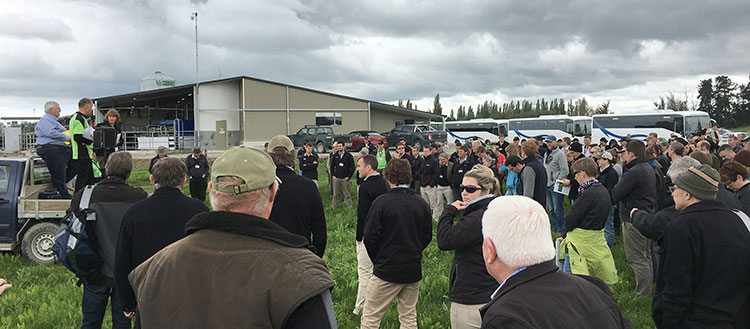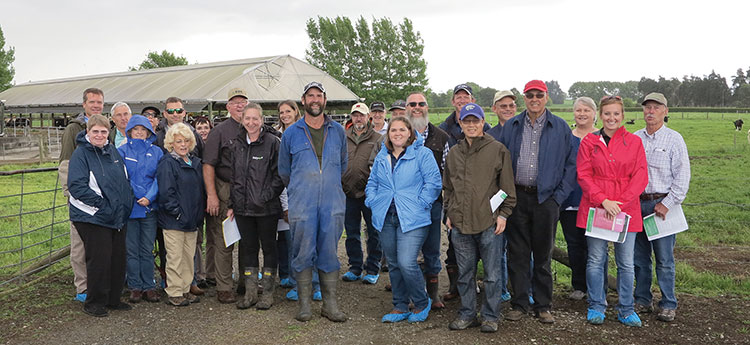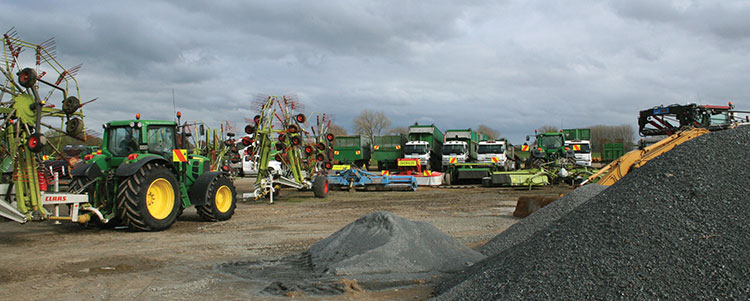Five lessons we could learn from Kiwis |
| By Dennis Hancock |
|
Over 300 farmers and ag professionals took part in the New Zealand Grasslands Association Conference and listened to Alvin and Judith Reid describe why and how they use robotic milkers on their pasture-based dairy. |
|
The author is an extension forage specialist, University of Georgia.  Over 300 farmers and ag professionals took part in the New Zealand Grasslands Association Conference and listened to Alvin and Judith Reid describe why and how they use robotic milkers on their pasture-based dairy. A group of us from the American Forage and Grassland Council (AFGC) took a tour of New Zealand to learn more. Our group of 22 included a diverse mix of extension specialists and county agents, seed company representatives, and livestock producers from Arkansas, Georgia, Indiana, Kansas, Kentucky, Mississippi, New Mexico, Oregon, and Tennessee. The goal for our trip was to visit this legendary place and to foster more of a connection with our colleagues and counterparts in their beautiful country. In addition to numerous farm visits, we ended our visit by taking part in the annual conference of the New Zealand Grassland Association, the sister organization to AFGC. It was a wonderful experience, and along the way we learned a lot from our newfound friends. For some of us, the experience was transformative. So, here we share the top five lessons we could learn from the New Zealand agricultural industry.  After a visit to a hybrid pasture-based dairy in the Waikato Region, the tour group posed for a photo with our farm hosts and representatives from DairyNZ and CRV International. 5. Learn from the neighbors and your competition It is ironic that we refer to New Zealanders as “Kiwis,” as they share few similarities with the flightless bird found only in New Zealand. Before mankind settled on the land and brought predators with them, they did not need to fly. Now, Kiwis are endangered. In contrast, New Zealanders take flight more than any people-group I’ve ever encountered. Nearly every Kiwi I know has traveled to several foreign countries, often spending months or years abroad. They are well-informed about agriculture around the world, and that is a competitive advantage for them. International trade is crucial to their ag economy. For example, New Zealand’s dairymen-owned milk cooperative, Fonterra, has around 30 percent market share of world dairy exports. So, it is incredibly important for Kiwis to be knowledgeable about global trade issues and even the politics of their trade partners and rivals. Another surprising trait among Kiwi farmers is that they regularly meet on one another’s farms for “discussion group” sessions. These “discussion groups” consist of 10 to 20 farmers gathering together to discuss a particular topic or theme and see how the host farm is dealing with the issue. The farmers often vigorously debate the subject and critique one another on how they are handling the issue. This has proven to be a very effective way of helping the members of the discussion group correct or avoid costly mistakes. 4. Be at the table, not on the menu The ag industry may be the largest contributor to the economy, but every Kiwi knows that tourism is a close second. The country is incredibly beautiful. There are scenic vistas in every direction, especially the rolling grass-covered hills. Much of the countryside is pristine, with rivers that are crystal clear and lakes that are a brilliant blue. These characteristics attract tourists and their money. Any activity that has or potentially could result in pollution has come under an intense regulatory burden, and the ag industry has the largest target on its back. Interestingly, many Kiwi farmers have decided to be part of the regulatory process. Several of the farmers whom we visited volunteer to serve on regulatory panels and commissions. From that vantage point, the farmers can engage in policy-making and voice the concerns of the farming community. Like the U.S., farmers are vastly outnumbered by urban and suburbanites. So, “the farmer” is largely a faceless unknown to the majority of regulators. By having a seat at the regulatory table, they help put a face to the community and humanize the implications of the policies. As one of the farmers we visited said, “I feel I have to have a seat at the table. Otherwise, I may be on the menu.” 3. Hire it done Almost every beef, sheep, and dairy farm that we visited had only one tractor, a mower to clip pastures, and maybe a small sprayer. Most would hire in any jobs that required equipment. The only other piece of equipment that they typically owned would be a motorbike (motorcycle) or quad (four-wheeler/utility vehicle). Almost none of the farms had a truck and trailer to haul livestock; however, nearly all of the farms had four-wheel drive midsized pickup trucks, most less than 1/2-ton capacity. If they needed baleage baled, livestock hauled, or silage harvested, they hired it done. Every rural community had three or more agricultural contractors who did the work at a fair price and in a reasonable time frame. For them, there was no need to have a lot of painted steel and the payments that come with it. Yet, the irony of this is that just about every rural town big enough to have a department store would have two or more equipment dealerships. The service contractors were doing enough business to keep a steady supply of new agricultural equipment flowing to the rural areas. 2. Know your numbers We toured both the North and South Islands of New Zealand and visited 18 different farms in total. Some of these were small farms run by just the husband and wife, while others operated more than 10,000 acres with several employees. Regardless of whether it was a dairy, beef, sheep, or crop farm, every farm owner or manager that we asked could state their cost of production to the nearest penny. They also could quote their farm’s total production and measures of efficiency (for example, kilograms (kg) of milk solids per hectare, kg of milk solids per kg of cow weight, lambing percentage, kg of beef produced per hectare, and so forth). We were too polite to directly ask about profit, but I am satisfied that they could quote their profit per hectare and return on investment without missing a beat. Sure, they could have made up the numbers on the spot, but I believe they were being open and honest.  Agricultural contractors are hired to do most jobs requiring equipment, including making and hauling baleage and silage. 1. Support comes from within Farming in New Zealand has no safety net. In the mid-1980s, the New Zealand government removed all subsidies, tax breaks, and price supports. The ax was even taken to their version of the extension service. These actions were brutal and extreme, but once the metaphorical Band-Aid was ripped off, the wound healed rather quickly. You would be hard pressed to find a Kiwi farmer who would want their government aid back. Now, the industry is rather self-sufficient. A levy on every animal or kg of milk solid processed in New Zealand funds nearly all research and extension activities, as well as efforts for the benefit of the industry. In U.S. dollars, these levies are $3.20 per head for beef, 43 cents per head for sheep, and 2.6 cents per kg of milk solids. These levies are renewed by a farmer-only referendum every six years. The outcome of the referendums demonstrates their appeal, as those voting to renew usually exceed 80 percent. Risk management includes some insurance policies against weather extremes and catastrophes, but many farmers also hold shares in the cooperatives they run to market their product. This provides a significant hedge, as dividends paid on value added further up the supply chain than the farm gate helps to provide additional income. This article appeared in the March 2017 issue of Hay & Forage Grower on page 6.
Not a subscriber? Click to get the print magazine. |
